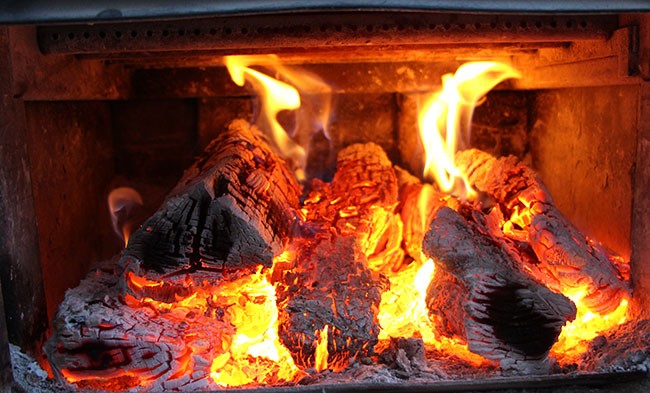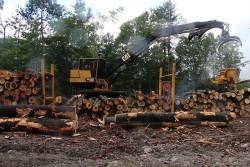This letter came in to us the other day.
To the Editors:
By this time, you and many of your Vermont readers have most likely heard the podcast on VPR on wood heat. It was a good and thorough treatment of the subject, but there was some material on the “con” side by academic experts that I question and I think your magazine is a good forum for discussing it. I’ve heard these concerns voiced in other places and it leaves me wondering if these academics spend much time in the woods. They don’t seem to be familiar with how the forest really responds to a harvest.
They point out that it could take 60 to 100 years for a new tree to grow to the size of the harvested tree, and they contend therefore that it will take that long for the CO2 released by burning to be reabsorbed by the forest. They claim further that this is too long to alleviate the immediate crisis with global warming.
Now there are several things wrong with this analysis. Replacement trees don’t wait 60 years to take up all the CO2, but begin as soon as they start growing and take it up all during their lives at an ever increasing rate. [Editor’s Note: Check out this op-ed that we ran in 2011 by William Strauss that quantifies this point and perspective.]
Another flaw in the analysis is that it only looks at the replacement trees and not at how the forest as a whole responds. Arguably the most drastic harvesting we can do is a clearcut. In this case there is a profound response in the next growing season in that a very dense stand of annual and biennials rapidly establishes itself along with the tree seedlings. This stand takes up far more CO2 than the just-sprouted replacement tree. This succession goes on, and the area eventually becoming a thick stand of pole wood, out of which the ultimate survivors will be the replacement trees. It has a very large CO2 uptake.
Of course all of these die except the replacement trees, but even dead they store a lot of carbon. Some of this is released as the dead wood rots, but some is sequestered as humus in the soil. The point here is that all of the plants in the succession grab on to CO2 during all the years until the replacement trees are harvested and the process begins again.
Any comments on the above are welcome.
Arthur Krueger
Shrewsbury, VT
This seems like an informed and well-reasoned reaction to me, Arthur. Some comments:
The 60- to 100-year figure was provided by Dartmouth professor Andrew Friedland, who has a reputation for being a provocateur on this subject – here’s a blog I wrote in 2013 in response to one of his talks. I sent Friedland an email asking him to explain the scenario where you’d get a 100-year debt; specifically, I asked how we got from a 30-year debt, which was the headline that came out of the big Manomet carbon accounting study we covered about 10 years ago, to a 100-year debt. He wrote back: “Since [the Manomet study], there has been a body of literature, including some contributed by my lab, that suggests that deep mineral soil carbon (20 cm to 60 cm below the O horizon) is lost in the 15 to 30 years after logging and can take ~75 years to recover. So I am also including that. Perhaps 100 years is on the high end, but I certainly do not think that there is justification to assume that all carbon released after clearing and burning a stand is reclaimed in 30 years.”
So there’s his logic. He would acknowledge the flush of growth you rightly point out that is sequestering carbon in a clearcut, but he’d say you’re not taking into account what’s going on in the soil. You can read one of his related papers here. The Cliff’s Notes version is that a significant amount of carbon is sequestered in the soil. And when a stand is clearcut, we don’t know for sure how that effects deep soil carbon stores. If the soil gets scarified, or compacted, or blasted with sun and rain because there’s no longer a canopy, then the soil chemistry may change, and we might lose a percentage of the carbon that was sequestered in the deep mineral soil. (In this particular study, there was no difference in C levels in the top 20 cm of soil compared to stands that hadn’t been harvested, but the uncut stands had 5 to 31 percent more carbon in the mineral soil.) The paper admits to statistically insignificant data and states: “at present, researchers do not have a full understanding of how and on what timescale soil C responds to forest harvest.” In other words, it’s good science. Friedland’s found a niche that hasn’t been well studied. He’s documented something that bears looking into. Other researchers will consider his work and scrutinize it, try to replicate it and report on what they find at their sites. Grad students will scratch their heads and try to figure out a better way to quantify things; better methods that might be used. This will unfold over decades and we’ll learn a little bit more with every incarnation.
What I agree is not good, as you allude to, is cherry picking the idea of a theoretical 60- to 100-year carbon debt and plastering it on a figurative billboard, because it’s not grounded in reality and it confuses people. Note the phrase “clearing and burning a stand” in his note to me. This scenario seems to be what the big-number carbon debt models are based on, and yet this hasn’t happened commercially in the Northeast since we were a colony sending potash back to Great Britain. So much of the firewood on the market in Vermont and the rest of the region comes from thinnings, where the overstory is not completely removed. The soil in this case is not radically disturbed, and the trees that are left flourish and sequester carbon more efficiently. And even if the land is clearcut, I can’t imagine a modern scenario where all the wood gets burned, which would affect the carbon debt calculation. In the gallery below you can see a sorting bunk in front of a slasher – this was part of a clearcut we had done last summer. As the wood was cut to length, the operator graded it. In the case of this job, 44 percent of the wood became either pellets or firewood, the rest went out as sawlogs or pulp, and the carbon in that wood was sequestered in 2x4s and cardboard boxes.
“Well what if all the wood did get burned?”
“What if the logger, with a family and mortgage and debt up to his eyeballs on a $300,000 feller buncher, decided he’d drive a load of sawlogs worth $3,000 to the pellet mill and get paid $700 for it?
“Yeah.”
What use is this intellectual exercise outside of academia? And what damage does this sow in a region where we have the resource base, and a logging culture, and the institutional knowledge to harvest and use wood more efficiently and responsibly than anywhere else in the world. And yet we spite our own face. The planet’s falling apart because of fossil fuel emissions and we dither.
I apologize, Arthur, for getting on my soapbox. (Though you did start it.) The bottom line is that the inputs in these carbon-debt models – what kind of land, what kind of harvest – make a huge difference in the number at the end. In the aforementioned Manomet study, we were told that if you switched from oil/gas to wood pellets, in 50 years you’d reduce your greenhouse gas emissions by 25 percent. The Northern Forest Center asked one of that study’s authors to run the model again using different inputs that better reflected the reality on the ground in northern New England, and lo and behold switching to pellets resulted in a 50 percent reduction in greenhouse gases right away.
The simple truth is that we don’t have a complete grasp on the carbon implications of burning wood, which is a statement meant to reflect the things we’re still learning, like how logging effects deep carbon stores in the soil, and the things that we just won’t ever know, like when the next ice storm is going to level a stand of trees that some model assumed would sequester X amount of carbon over the next 50 years. I’d be wary of anyone who pretends to know otherwise. The best we can say right now is that when we cut and burn a tree, it will take some amount of time – a timeframe ranging from negligible to decades – to offset the emissions produced.
What we do know with absolute certainty, though, is that from a carbon emission perspective, burning wood is always better than burning coal or gas or oil, since none of that fossilized carbon should be in our atmosphere. And we do know burning wood provides the financial means to keep new forests growing, and gives our friends and neighbors jobs, and it’s cozy, and all the other good points the VPR piece makes. You might look at burning wood like you’d look at eating butter. Do you want to be aware of the health implications and moderate your intake? Yes. But there’s no reason to be scared of it. It’s natural; our bodies are built to handle it in moderation. Burning fossil fuels is like eating artificial trans-fat. It’s unnatural and bad for you in all cases.
Alright, choir (and those who want to tell us what we're missing): the floor is yours.






Discussion *